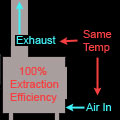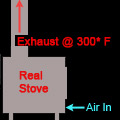 Because wood sells by the cord, not the pound, you'll get best results burning the highest density (heaviest) wood that can be found in your
area. Here's why: let's say you can fit 2 cu.ft. of wood in your stove. That would be about 114 lbs. of Osage Orange, but only 54 lbs. of Willow.
Since all species of wood are presumed to contain the same heat value per pound, you're going to get twice the heat value out of each load of the
twice-as-heavy Osage Orange! Because wood sells by the cord, not the pound, you'll get best results burning the highest density (heaviest) wood that can be found in your
area. Here's why: let's say you can fit 2 cu.ft. of wood in your stove. That would be about 114 lbs. of Osage Orange, but only 54 lbs. of Willow.
Since all species of wood are presumed to contain the same heat value per pound, you're going to get twice the heat value out of each load of the
twice-as-heavy Osage Orange!
You can find many charts online that purport to show the available btu content per cord of various species of firewood. On the surface, creating
these charts appears to be a fairly simple undertaking: multiply the weight of a cubic foot of a given species by the number of cubic feet in a cord to
determine the weight of a cord. Then, multiply that weight by how many btu's of heat you can get out of each pound of wood to determine how
many MBTU's (Million BTU's) of heat are available in that cord. Here's a formula view:
lbs/cu.ft.
x (cu.ft./cord)
= (lbs/cord)
(lbs/cord) x (btu/lb)
= (btu/cord) |
Seems simple, yes? All we need to do now is determine the values to plug into our formula.
The first thing we'll need to know is the weight of one cubic foot of a given species. One way to determine this would be to whack off a
one-cubic-foot chunk and weigh it, but that's a lot of work, given the vast number of species used for firewood. What we need is a firewood weight
chart!
There are any number of charts available showing the weight per cubic foot of various species of wood cut right off the tree. Those charts aren't
going to do us any good, because fresh-cut wood contains WAY more water than seasoned fuelwood, and is therefore WAY heavier. We're not
going to be burning freshly cut wood: we need to know the weight of each species after it is seasoned and ready to burn.
Fortunately, the good folks at The Engineering Toolbox have published a list showing the weight of various wood species at 20% moisture content,
which happens to be the approximate moisture content of properly seasoned firewood. From the list, we find that a cubic foot of Osage Orange at
20% moisture content weighs 57 pounds.
We're on the way! Our formula for Osage Orange now looks like this:
57
lbs/cu.ft.
x (cu.ft./cord)
= (lbs/cord)
(lbs/cord) x (btu/lb)
= (btu/cord) |
Next we need to decide how many cubic feet of wood there are in a cord. This seems easy, as a cord is defined as a tight stack measuring 4' x 4' x
8', which comes to 128 cu.ft., the number many firewood heat-value charts use. If you look at a cord of wood, however, you'll see there are lots of
spaces between the individual pieces. And those spaces don't have any fuel value at all. Way back in the 1970's, a study at Oregon State University
concluded that, although a cord of wood takes up 128 cu.ft. of space, it contains an average of just 85 cu.ft. of wood.
So that's the number we'll use in our formula:
57
lbs/cu.ft.
x 85 (cu.ft./cord)
= 4845
(lbs/cord)
4845 (lbs/cord)
x (btu/lb)
= (btu/cord) |
Now that we have determined how much our cord of Osage Orange weighs, we'll need to know how many btu's of usable heat each pound of wood
contains so we can complete the second line of our formula.
In a laboratory, using an oxygen bomb calorimeter to burn bone-dry wood ( 0% moisture content ) in an atmosphere of pure oxygen, it is possible to
extract 8660 btu's from a pound of wood. That number, known as the Absolute Heat Value, is sometimes used in scientific calculations:

Oxygen Bomb Calorimeter | + |

Wood at 0% Moisture Content | = |
8660 btu/lb
(Absolute Heat Value of Fuel Wood) |
Well, we're not going to use that number. While useful in analyzing theoretical problems, the absolute fuel value of wood does not reflect
real-world available heat.
For one thing, we're not burning pure oxygen in our wood stoves.
For another, the wood we burn is not dried to 0% moisture content: as mentioned above, even a well-seasoned woodpile will contain about 20%
moisture, which doesn't produce any heat in the fire. A 1-lb. stick of wood at 20% moisture content is only 80% wood, so it only contains about 6928
btu's of available heat energy (8660 x 80%). This is known as the High, or Theoretical Heat Value of fuel wood:

100% Efficient Stove | + |

Fuel Wood at 20% Moisture Content | = |
6928 btu/lb
(High Heat Value of Fuel Wood) |
We're not going to use that number either. The graphic formula shown above, while
useful in determining the efficiency of a given wood stove, still doesn't reflect a real-world
situation, because it is not possible for a wood stove to extract 100% of the Heat Value to the room. The explanation is twofold:
1) A portion of the 6928 btu/lb must be used to boil away that 20% moisture content, as well as whatever humidity is present in the combustion air
and the water that is created as a product of combustion.
2) Another portion must be "lost" up the chimney to establish the average
250° - 300° F flue temperature necessary to maintain an adequate
updraft and prevent excessive creosote condensation.
We won't go into the math here, but the bottom line is, once we subtract the heat value needed to boil off the water and the heat value needed to
keep the chimney at 250° - 300° F, a pound of fuel wood at 20% moisture content actually contains only about 6200 btus that are available to be
delivered to the room. This is known as the Low, or Available Heat Value of fuel wood, and is the real-world number we'll use in our formula:

Real Stove w/ 300° Exhaust | + |

Fuel Wood at 20% Moisture Content | = |
6200 btu/lb
(Low Heat Value of Fuel Wood) |
Voila! Here's what we get when we plug in the Available Heat Value to finish our formula for Osage Orange:
Btu Value Per Cord: Osage Orange
57
lbs/cu.ft.
x 85 (cu.ft./cord)
= 4845
(lbs/cord)
4845 (lbs/cord)
x 6200
(btu/lb)
= 30
(mbtu/cord) |
Now, let's run the formula for Willow. On the Engineering Toolbox list, Willow at 20% moisture content weighs 27 lb./cu.ft:
Btu Value Per Cord: Willow
27
lbs/cu.ft.
x 85 (cu.ft./cord)
= 2295
(lbs/cord)
2295 (lbs/cord)
x 6200
(btu/lb)
= 14.2
(mbtu/cord) |
So you see, if your wood-seller is offering a cord of Osage Orange or a cord of Willow at the same price, you want to jump on the twice-as-heavy
Osage Orange.
For a link to two fuel value charts, the first one organizing various species by btu content, and the second organizing the same species
alphabetically for easy lookup, click here.
Review: Our firewood heat value figures are based on 6200 btu per pound at 20% moisture content, and 85 cu ft of wood per cord.
Regardless of what species of wood you burn, it won't produce optimal heat output and burn time unless it is properly seasoned. You can read more
about why you shouldn't burn unseasoned fuel wood
here.
|







